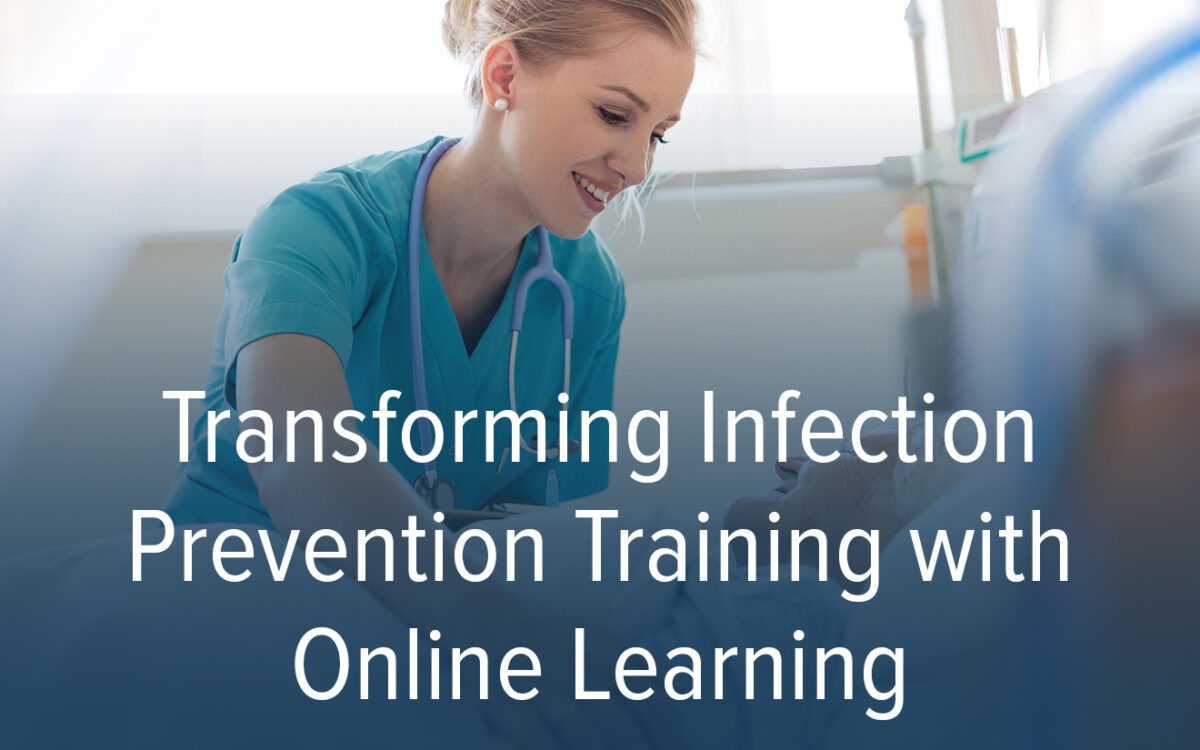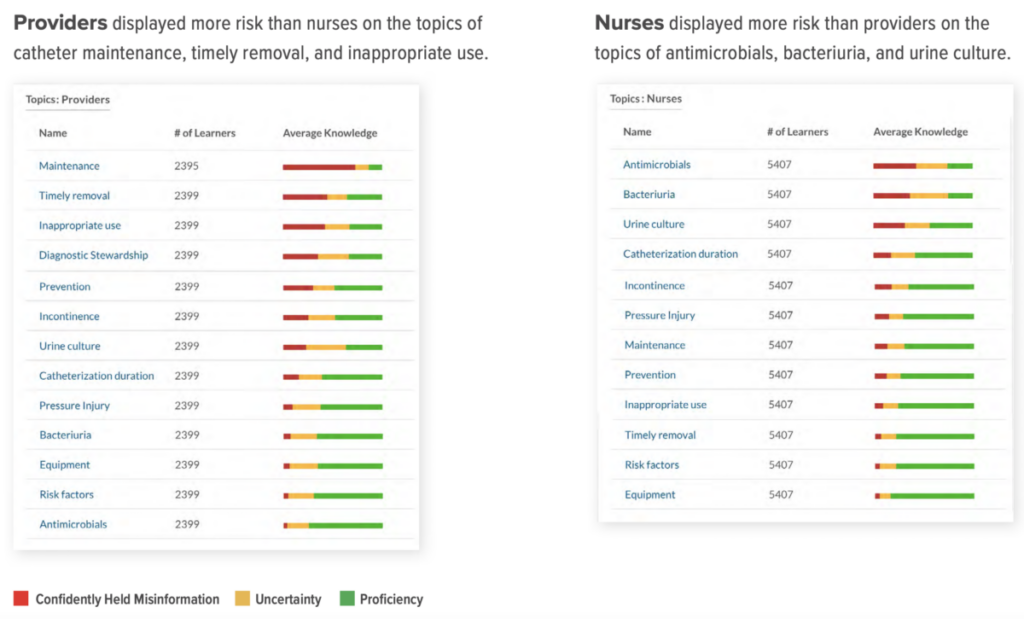
While hospitals continuously work to prevent healthcare-associated infections (HAIs), they still occur. With more reports highlighting staff shortages, burnout, and overwhelming workload — problems only exacerbated by the COVID-19 pandemic — people resort to shortcuts when there isn’t enough time to meet mounting demands. Despite staff being hyperaware of infection with reminders such as infection prevention “toolkits,” posters, and graphics, HAIs increased significantly in 2021, according to the CDC (CLABSI by 47% and CAUTI by 19%, for example).
And even still, hospitals continue to combat potentially deadly cases of HAIs. A narrative review of HAIs prevention strategies cites the Joint Commission Journal on Quality and Patient Safety’s report of healthcare workers’ reasons for non-compliance with updated guidelines — and most given reasons stem from a lack of education and training about the guidelines’ strictness. Healthcare workers also went on to report high workloads and feelings of burnout. Information overload while already feeling overwhelmed prevents workers from absorbing new guidelines quickly and effectively. Any information learned is likely to be forgotten in the stress of the job.
There is so much that goes into preventing HAIs that clinicians are responsible to know and execute with confidence every day. With constant pressures upon them — both systemic and job related — healthcare workers need that extra support from their organizations. That’s where effective and personalized learning can make a difference for both staff and patients’ safety.
Ultimately, it boils down to giving the highest quality care to patients. When mistakes are made and HAIs occur, patients, their families and their caregivers suffer — which poses an emotional burden to healthcare workers who aim to deliver the best patient care. Amid a healthcare worker crisis, it is up to organizations to offer as much support as possible. Regular training in infection prevention best practices is the best way to curb HAIs, but garnering buy-in for more training can be a hurdle. This is especially true if training efficacy can’t be measured. However, if training efficacy can be measured and has been shown to deliver significant ROI (such is the case with Amplifire), that may be the push you need to ensure your staff is well supported and performing at their highest potential.
Why science-based training matters
For learning to deliver tangible results, it has to stick. Amplifire’s platform is built from brain science discoveries that induce powerful, lasting learning at a much faster rate. These discoveries — pioneered by our Science Advisory Board — include “cognitive triggers” that have proven to help people learn faster and retain more, which provides an advantage when it comes to optimizing training.
The unfortunate reality is that people are designed to forget — it’s a natural part of being human. In fact, the process of forgetting is actually beneficial to cognition and learning (learn more about that intricate process here). But by harnessing the aforementioned cognitive triggers, Amplifire’s learning platform attacks what is known as the forgetting curve, forging stronger memories for information that matters, especially when it comes to infection prevention training.
Science-based training matters because it is the most effective way to ensure important, life-saving training sticks in the minds of learners. Major health systems that have partnered with Amplifire for infection prevention training have seen astonishing results, including significant reduction in HAIs and HAI-related deaths. Ultimately, infection prevention training should empower clinicians and help their organizations reduce HAIs. With the power of brain science and adaptive, personalized learning, Amplifire helps organizations reach their infection prevention training goals. Here’s how.
How Amplifire training delivers positive outcomes
For clinicians
In addition to applying brain science principles to learning, the Amplifire platform also rigorously personalizes the learning experience. Our adaptive platform tailors learning to each person by adjusting to individuals’ knowledge gaps, uncertainties, and misinformation. By personalizing the learning experience in this way, learners only spend time on the things they don’t know. This is important for clinicians because it:
- Respects clinicians’ time. Clinician satisfaction improves when organizations show they value their time and knowledge.
- Gets clinicians back on the floor faster. Clinicians spend less time in training and more time helping patients.
- Gives clinicians confidence. Clinicians feel better prepared to provide the best possible care for their patients, boosting morale.
In the figure below, Amplifire visualizes the importance of personalized learning in CAUTI prevention training at an East Coast hospital. Without Amplifire, there is no way to know exactly what each clinician does or does not know, posing a significant risk in HAI prevention.

In the CAUTI prevention course, clinicians and nurses posed different risks based on their differing knowledge gaps, uncertainties, and misinformation. Therefore, the Amplifire platform adapted their learning experience to their knowledge level for optimal learning, yielding the benefits described above from the clinician perspective.
What’s more, training doesn’t have to be boring, either. Personalized learning can combat adverse feelings associated with training. Amplifire has a gamification feel that stimulates dopamine and makes learning enjoyable.
For patients
Patients are at the center of all HAI prevention training objectives. The main goal of HAI training is not just to cut down on training time and associated costs, but it is to improve patient outcomes and save lives. Again, HAIs continued to increase significantly in 2021, even with scrupulous prevention efforts by healthcare organizations.
Despite the national average increase in HAIs, a hospital at a large U.S. healthcare system saw CLABSI rates fall by 79% in under a year following the adoption of Amplifire training. When compared to the control hospital, the result was undeniable.

Continuing the CAUTI example from the previous section, Amplifire training empowered those physicians and nurses to achieve a 38% decrease in CAUTI incidents. These HAI reductions have tangible effects on patient outcomes, and clinicians can be proud of the impact they’ve made in patients’ lives.
For organizations
For healthcare systems, clinician satisfaction and positive patient outcomes are of paramount importance. Organizations’ prosperity heavily depends on these factors.
Like we previously discussed, personalized learning allows learners to only spend time learning topics they don’t know, so they don’t waste time learning the things they’ve mastered. This effective and efficient learning model slashed learning time and cuts costs associated with more time spent learning and learning in the classroom if organizations haven’t yet adopted blended or virtual learning. It also allows providers to get back to the floor faster, increasing billable hours.
With clinicians who are more satisfied with training that respects their time and empowers them to do their best work confidently, hospitals achieve higher retention rates. By keeping good employees, hospitals cut onboarding costs and reduce turnovers.
In addition to diminished patient wellbeing, HAIs pose a significant monetary risk to organizations. It is estimated that 250,000 CLABSIs occur in the U.S. every year, and the AHRQ estimates the average cost of each CLABSI at approximately $48,108. At a health system that deployed Amplifire’s CLABSI training and decreased bloodstream infections by 49%, they achieved $3.8 million in savings. Imagine what the 79% reduction we described above could achieve in savings — savings that could be put to work to improve hospital prosperity, enabling health systems to provide top-tier care.
These points considered, the return on investment associated with Amplifire training can be as much as 25-fold. Effective training is absolutely critical to prosperity and future proofing your organization. Amplifire has proof of learning and powerful returns to show the value of a science-based, adaptive learning platform.
When lives are at stake, there is no place for shortcuts. Amplifire supports the Institute for Health Improvement’s Quadruple Aim, rounding off better health, better care, and low cost with clinician wellbeing. Clinicians are the backbone of patient care; when clinicians are well supported, especially with adequate and effective training, the core elements of what was formerly the Tripple Aim become more achievable. To be a well-rounded organization, it’s essential to empower employees with lifesaving, HAI-preventing training that propels your organization to prosperity.
From the beginning, Amplifire has relied on innovative brain science to guide its product development to create the most effective learning and training solution, perfectly tailored to the way the human brain works. Learn more about how Amplifire helps people learn better and faster by checking out a demo.







